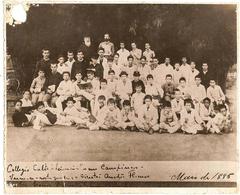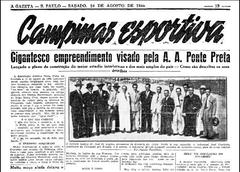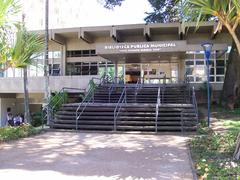Complete Guide to Visiting Train Stations in Campinas, Brazil: Visiting Hours, Tickets, and Tips
Date: 15/06/2025
Introduction
Campinas, one of São Paulo state’s most dynamic cities, boasts a railway legacy that has shaped its identity and urban landscape. As a major player during Brazil’s coffee export era, Campinas constructed a network of iconic train stations—most notably Estação Cultura and Anhumas Station—that served as gateways for economic prosperity and cultural exchange. Today, these historic sites invite visitors to experience a blend of architectural grandeur, vibrant cultural programming, and immersive heritage tourism.
This comprehensive guide explores the historical evolution of Campinas’ railways, details practical information for planning your visit—including hours, ticketing, and accessibility—and highlights the city’s ongoing preservation efforts. Discover the charm of VFCJ’s steam train rides, the allure of Estação Cultura’s cultural events, and the transformative promise of the upcoming Trem Intercidades (TIC) Project, which will reconnect Campinas to São Paulo with modern rail services.
Whether you’re a history enthusiast, railfan, or curious traveler, this guide ensures your visit is both memorable and informed.
Contents
- Historical Development of Campinas Railways
- Key Historic Train Stations
- Estação Cultura (Companhia Paulista Station)
- Anhumas Station & VFCJ Steam Train Rides
- Heritage Preservation & ABPF’s Role
- Architectural and Cultural Significance
- Practical Visitor Information
- Cultural Events and Community Engagement
- Urban Development and Railway Influence
- Visitor Tips & Safety
- The TIC Project: Modern Rail in Campinas
- Visiting Campinas Station: Practical Guide
- Summary, Resources, and FAQ
Historical Development of Campinas Railways
The railway era in Campinas began in 1867, linking the city to São Paulo and the port of Santos, catalyzing a boom in coffee exports and urban growth (kids.kiddle.co). Rail connectivity attracted waves of immigrants, fueling Campinas’ industrial and agricultural ascendancy. The iconic Companhia Paulista and Companhia Mogiana were instrumental, their stations symbolizing the city’s leap into modernity. While passenger rail declined in the late 20th century, concerted preservation efforts have ensured these landmarks remain vibrant parts of Campinas’ identity.
Key Historic Train Stations in Campinas
Estação Cultura (Old Companhia Paulista Station)
Once the bustling central station of the Companhia Paulista, Estação Cultura now stands as a monument to Campinas’ railway past—repurposed into a thriving cultural center. Its neoclassical architecture, arched windows, and historic clock tower offer a journey through time, while its halls host concerts, exhibitions, and workshops.
- Visiting Hours: Tuesday–Sunday, 10:00 AM–6:00 PM
- Tickets: Free entry; special events may require tickets
- Location: Praça Marechal Floriano Peixoto, central Campinas
Detailed architectural features and the adaptive reuse of this space underscore Campinas’ commitment to heritage and community (kids.kiddle.co).
Anhumas Station & VFCJ Steam Train Rides
Located on the city’s outskirts, Anhumas Station is home to the Associação Brasileira de Preservação Ferroviária (ABPF) and the beloved Viação Férrea Campinas-Jaguariúna (VFCJ) steam train. Since the late 1970s, ABPF volunteers have restored locomotives and tracks, offering nostalgic rides through picturesque countryside and historic stations between Campinas and Jaguariúna (abpf.com.br).
- Visiting Hours: Weekends and holidays, 9:00 AM–5:00 PM
- Tickets: ~BRL 60 for adults; discounts for children/seniors. Book in advance via ABPF.
- Guided Tours: Available by request through ABPF
The journey is a highlight for families and history lovers alike.
Heritage Preservation & ABPF’s Role
The ABPF leads Brazil’s railway preservation, rehabilitating stations, restoring rolling stock, and operating heritage trains. Their hands-on projects balance historical authenticity with modern safety, funded through public grants, donations, and tourism revenue (abpf.com.br). Preservation initiatives not only safeguard architectural treasures but also drive heritage tourism and community pride (railzoom.com).
Architectural and Cultural Significance
Urban Evolution and Architectural Grandeur
Campinas’ stations, especially Estação Cultura, reflect the city’s 19th-century transformation. With influences from European railway architecture—think London’s St Pancras or New York’s Grand Central—these stations became civic symbols of progress (Parametric Architecture). Features like high ceilings, arched windows, and ornate brickwork remain, even as the buildings have been adapted for new uses (Wanderlog).
Integration with Modern Transit
While original rail lines have given way to bus rapid transit (BRT) systems, Campinas’ urban landscape still honors its railway roots. Contemporary BRT terminals often neighbor historic stations, and public art or preserved elements commemorate the city’s transport heritage (MetroRouteAtlas).
Practical Visitor Information
Estação Cultura
- Hours: Tuesday–Sunday, 10:00 AM–6:00 PM (closed Mondays/holidays)
- Entry: Free; ticketed for special events
- Accessibility: Wheelchair accessible with ramps/elevators; check specific events for details
Anhumas Station & VFCJ
- Hours: Weekends/holidays, 9:00 AM–5:00 PM
- Tickets: Purchase online at ABPF
- Accessibility: Most areas accessible; contact in advance for accommodations
Getting There
- Public Transit: Multiple bus lines and BRT connect to Estação Cultura; Anhumas Station is best accessed by car or taxi.
- By Car: Parking available but limited in downtown; traffic can be heavy.
Cultural Events and Community Engagement
Estação Cultura’s transformation into a cultural hub has made it a focal point for music, art, and festivals. Permanent exhibits chronicle Campinas’ rail heritage, and special events foster civic pride and learning (Triplyzer). The VFCJ steam train experience includes themed rides with live music and historical reenactments (BrazilBlogged).
Urban Development and Railway Influence
Railway stations shaped Campinas’ urban layout, anchoring neighborhoods and commercial districts. The conversion of rail corridors into BRT lines and the adaptive reuse of stations evidence the lasting influence of the railway era (MetroRouteAtlas).
Visitor Tips & Safety
- Photography: Both stations are ideal for photography—capture details of the Victorian brickwork and bustling cultural events.
- Best Times: Visit on weekdays or early afternoons for fewer crowds; check for special events.
- Language: Portuguese is predominant; translation apps or basic phrases are helpful.
- Safety: Campinas is safe for tourists, but always use official transport, keep valuables secure, and avoid poorly lit areas at night (travelinglifestyle.net).
- Support Preservation: Donate, buy souvenirs, or volunteer with ABPF (abpf.com.br).
The TIC Project: Modern Rail in Campinas
What is the TIC Project?
The Trem Intercidades (TIC) Project will link Campinas and São Paulo with a medium-speed rail system, offering rapid, comfortable, and sustainable travel (Railway Gazette). This public-private partnership represents a new era for regional mobility.
Key Details
- Route: São Paulo – Jundiaí – Campinas (101 km)
- Completion: TIC (2031); TIM (2029)
- Frequency: Every 15 minutes (peak)
- Ticket Price: ~R$50 full journey; integrated with Bilhete Único
- Accessibility: Fully accessible stations/trains
- Ridership: Up to 672,000 passengers daily (Railway Pro)
Why It Matters
The TIC will cut travel times, reduce highway congestion, and spur urban renewal near stations (Mobilidade360). For visitors, it offers seamless access to Campinas’ cultural and historical sites.
Visiting Campinas Station: Practical Guide
Location & Accessibility
Estação Cultura is centrally located and accessible via public transport, with nearby attractions like Mercado Municipal and the Metropolitan Cathedral (Wanderlog - Campinas Attractions).
Visiting Hours & Tickets
- Hours: Standard business hours; verify for special events (Triplyzer - Estação Cultura)
- Tickets: Free, with exceptions for special performances
What to See
- Permanent Exhibitions: Railway artifacts and interactive history displays
- Cultural Events: Music, theater, arts
- Architecture: Victorian brickwork, ironwork, and the 200-meter pedestrian tunnel (Wikipedia - Campinas Station)
Getting There
- By Bus: Multiple lines stop nearby; Bilhete Único card recommended (Wikivoyage - Campinas)
- By Taxi/Rideshare: Readily available, advisable at night
- By Car: Parking available, but plan for downtown congestion (Wild Trips - Campinas)
Safety & Accessibility
The station is largely accessible, though some historic surfaces may be uneven. Adhere to standard safety precautions.
FAQ
Q: What are the visiting hours of Estação Cultura?
A: Tuesday–Sunday, 10:00 AM–6:00 PM. Closed Mondays/holidays.
Q: Is entry free?
A: Yes, except for some special events.
Q: Are guided tours offered?
A: Yes, especially during special events or by arrangement.
Q: How accessible are the stations?
A: Both Estação Cultura and Anhumas Station are mostly accessible; contact in advance for specific requirements.
Q: How can I buy VFCJ train tickets?
A: Online at ABPF’s website.
Q: When will the TIC Project be operational?
A: Express service is scheduled for 2031; check official sources for updates.
Summary and Call to Action
Campinas’ train stations represent a unique convergence of history, architecture, and vibrant community life. From the stately Estação Cultura to the scenic VFCJ steam train rides, these sites offer immersive experiences for all ages. The forthcoming TIC Project promises to further enhance connectivity and tourism.
To plan your visit, check current hours and ticket info, support heritage initiatives, and immerse yourself in Campinas’ living railway legacy. Download the Audiala app for event updates and guided tours, visit the ABPF website, and follow local tourism platforms for the latest news.
References
- ABPF – Associação Brasileira de Preservação Ferroviária
- Triplyzer – Things to do in Campinas
- Railway Gazette – TIC Project
- Railway Pro – TIC Project Investment
- Wikipedia – Campinas Station
- BrazilBlogged – Maria Fumaça Steam Train
- Wikivoyage – Campinas
- Parametric Architecture – Historic Train Stations
- Railzoom – Heritage Railways
- MetroRouteAtlas – Campinas Transport
- Wanderlog – Campinas Attractions
- Mobilidade360 – TIC Construction
- Wild Trips – Campinas
- Trek Zone – Campinas
- HelloTravel – Campinas





